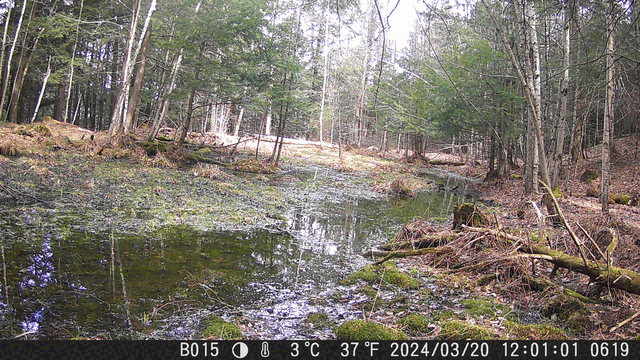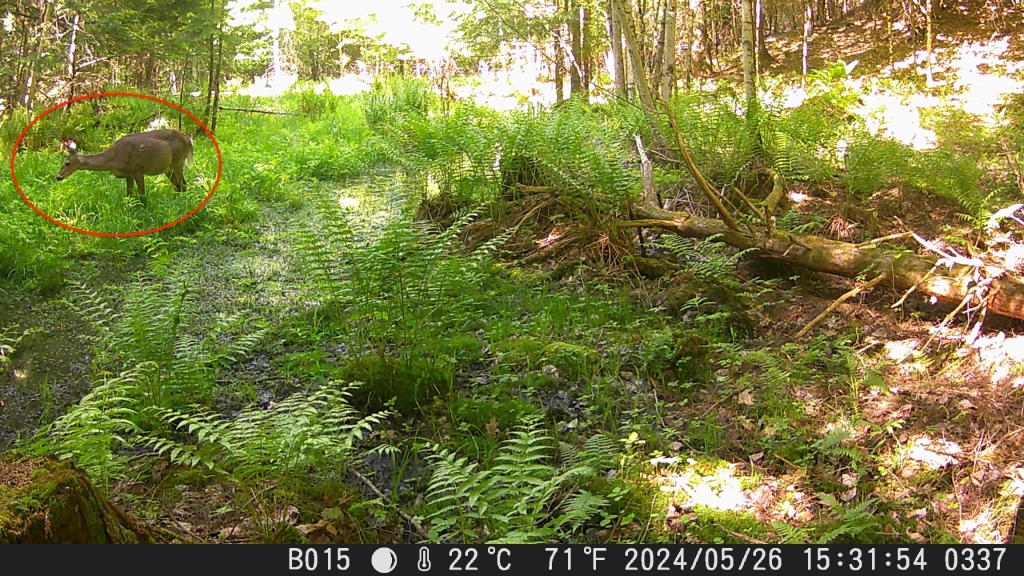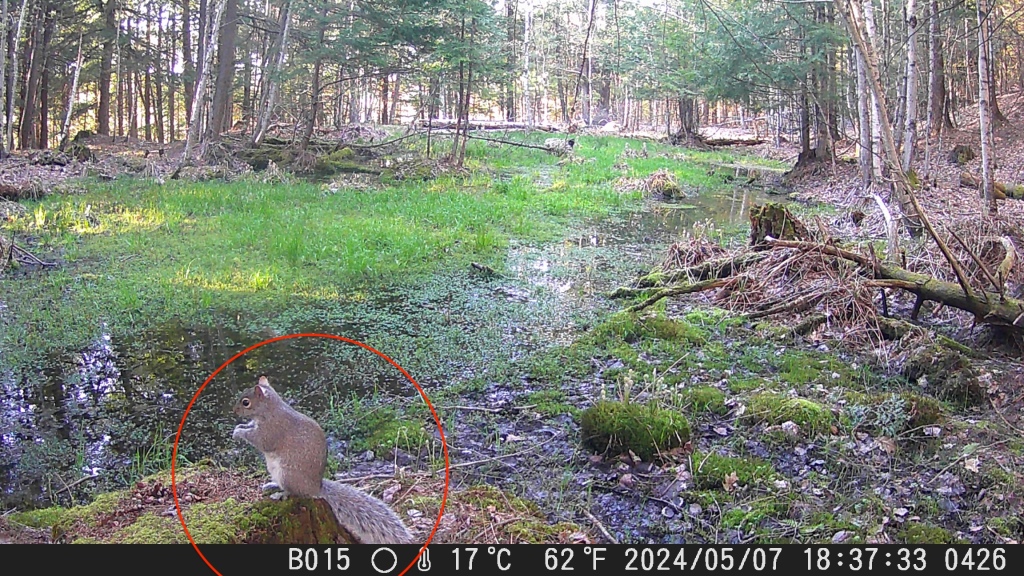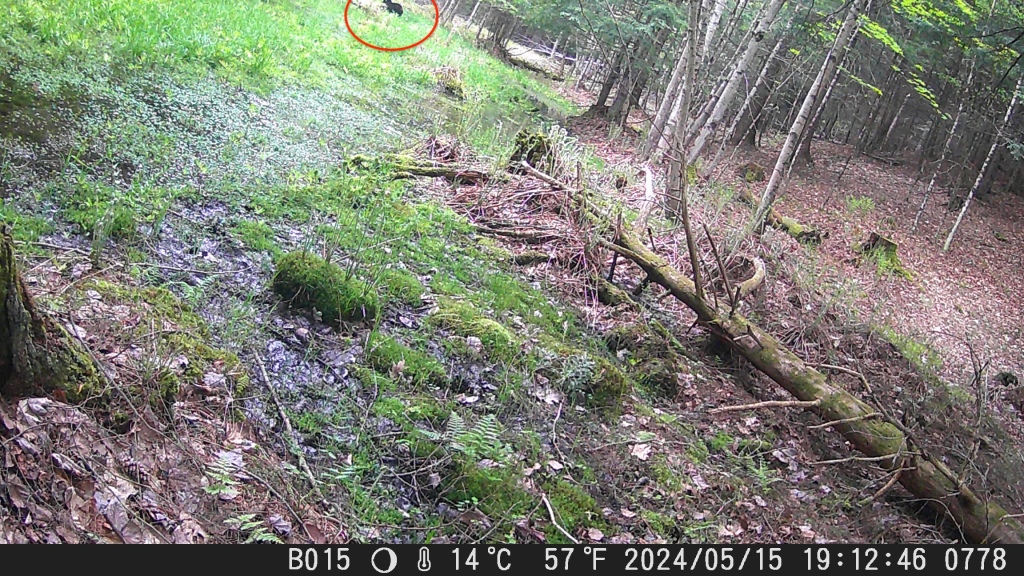As regular readers know, I have placed several wildlife cameras in a forest near home, and have captured many enjoyable videos of wildlife like deer, bear, fox, coyote, bobcat, turkey, and more. The same cameras can be set to capture photos on a regular schedule, which can later be stitched into a timelapse video. Back in March, a few days before the spring equinox, I placed a camera at the edge of what I knew to be a vernal pool; this month, a few days after the summer solstice, I removed the camera. The camera snapped an image every five minutes from sunrise to sunset, resulting in 14,697 images. Watch the pool evolve from a snowy landscape into a lush fern-filled glade. Watch the heavy snow of March 23 lay its burden on the branches, and then watch those branches relax on March 23 and 25; watch the pool freeze and then re-thaw; watch the April 4th snowstorm bury the pool once again; watch snow melt and the grasses stretch toward the April sun; watch the ferns unfurl into the May sunshine. Below is an abbreviated timelapse, one photo per day at noon. See the full-res noon-time video (1 minute), and the full-length video (10 minutes). If you watch very, very closely, you might see a animal or two.

By stepping through the entire sequence, image by image, one at a time, I occasionally got to see some of the critters who visit the pool, like these…





All the above photos and videos are in a gallery.
Technical notes:
This was an experiment – my first timelapse – and I learned a lot along the way. Here are some details, some choices I made, and some lessons learned.
- equinox was on Tuesday, March 19, 2024 at 11:06 pm EDT (Manchester, NH); I deleted all images before that time.
- solstice was on Thursday, June 20, 2024 at 4:50 pm EDT (Manchester, NH); I deleted all images after that time.
- every five minutes, because I calculated this would give me about 140-170 images per day, which if paced at 25 frames per second would allow each day to pass in about 5-7 seconds. I was aiming for a watchable video, while also managing camera battery and memory capacity.
- sunrise to sunset, approximately: I set the camera to start taking photos at a time close to sunrise, and to stop at a time close to sunset, and adjusted this time range every few weeks; thus, in the resulting movie, the days get longer as Spring progresses. I likely missed some images at the extreme ends of the day.
- deleted night-mode images: in low light, the camera automatically turns on an infrared light and captures photos in black and white; this sometimes happens in the dim light just after sunrise and just before sunset. I deleted those images because the sudden change to black-and-white images is jarring.
- deleted selfie images: I checked on the camera every ~2 weeks, replacing the memory card, ensuring the batteries were full, and wiping dust and pollen off the lens. Despite being a fast worker, a couple of times I was captured in a photo! I deleted those photos.
- camera angle: Unfortunately, as you see in the movie, sometimes the angle of the camera shifts – because I had to open (and thus move) the camera when servicing it. Also, at least twice, a bear came by and messed with the camera, leaving it askew! I think it was a bear, because I have video of bears messing with my other cameras, and because this camera has an image or two just before (or after) the camera shift in which I can just make out a bear coming (or going). Sigh.
- camera lens: it rained and snowed. Sometimes, snowflakes or water drops would land on the lens and stay for hours, leading to blurry images. In May, there was a lot of pollen, and it would coat the lens too.
- camera exposure: the camera manages exposure automatically; this scene has high dynamic range (deep shadows, and sunny open patches), which means sometimes the camera over- or under-exposed, and that makes for a flickering timelapse. I’d rather use a manual-exposure camera and set a fixed exposure.
- camera resolution: 2304 × 1296 pixels, leading to video a bit better than 1080p.
- timelapse production: although fancy tools exist, I used a simple command-line tool with which I am familiar (and which is always installed on my laptop): ImageMagick. I used simple commands to make…
the full movie,convert -delay 1 *jpg movie.mov
the noon-time gif,convert -resize 640x -delay 50 *.jpg movie.gif
the noon-time movie,convert -delay 50 *.jpg movie.mov
